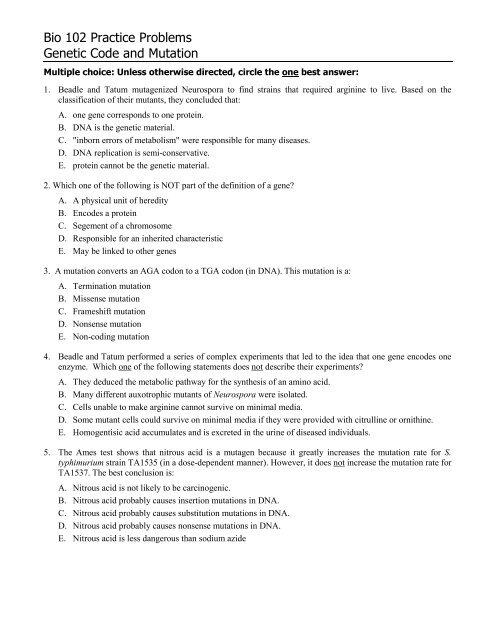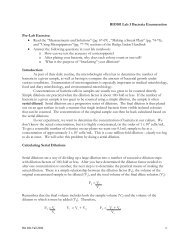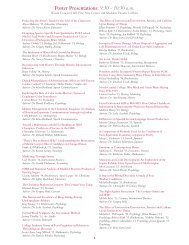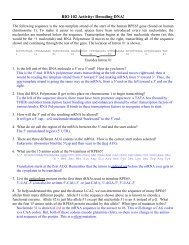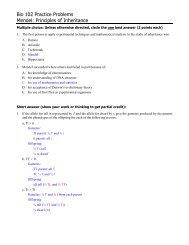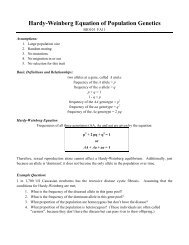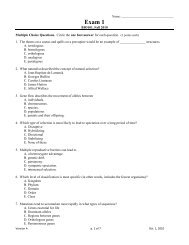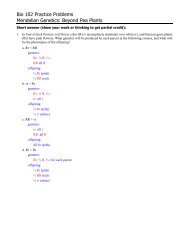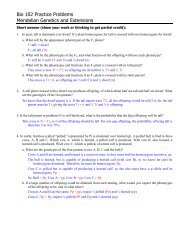Bio 102 Practice Problems Genetic Code and Mutation
Bio 102 Practice Problems Genetic Code and Mutation
Bio 102 Practice Problems Genetic Code and Mutation
You also want an ePaper? Increase the reach of your titles
YUMPU automatically turns print PDFs into web optimized ePapers that Google loves.
<strong>Bio</strong> <strong>102</strong> <strong>Practice</strong> <strong>Problems</strong><br />
<strong>Genetic</strong> <strong>Code</strong> <strong>and</strong> <strong>Mutation</strong><br />
Multiple choice: Unless otherwise directed, circle the one best answer:<br />
1. Beadle <strong>and</strong> Tatum mutagenized Neurospora to find strains that required arginine to live. Based on the<br />
classification of their mutants, they concluded that:<br />
A. one gene corresponds to one protein.<br />
B. DNA is the genetic material.<br />
C. "inborn errors of metabolism" were responsible for many diseases.<br />
D. DNA replication is semi-conservative.<br />
E. protein cannot be the genetic material.<br />
2. Which one of the following is NOT part of the definition of a gene?<br />
A. A physical unit of heredity<br />
B. Encodes a protein<br />
C. Segement of a chromosome<br />
D. Responsible for an inherited characteristic<br />
E. May be linked to other genes<br />
3. A mutation converts an AGA codon to a TGA codon (in DNA). This mutation is a:<br />
A. Termination mutation<br />
B. Missense mutation<br />
C. Frameshift mutation<br />
D. Nonsense mutation<br />
E. Non-coding mutation<br />
4. Beadle <strong>and</strong> Tatum performed a series of complex experiments that led to the idea that one gene encodes one<br />
enzyme. Which one of the following statements does not describe their experiments?<br />
A. They deduced the metabolic pathway for the synthesis of an amino acid.<br />
B. Many different auxotrophic mutants of Neurospora were isolated.<br />
C. Cells unable to make arginine cannot survive on minimal media.<br />
D. Some mutant cells could survive on minimal media if they were provided with citrulline or ornithine.<br />
E. Homogentisic acid accumulates <strong>and</strong> is excreted in the urine of diseased individuals.<br />
5. The Ames test shows that nitrous acid is a mutagen because it greatly increases the mutation rate for S.<br />
typhimurium strain TA1535 (in a dose-dependent manner). However, it does not increase the mutation rate for<br />
TA1537. The best conclusion is:<br />
A. Nitrous acid is not likely to be carcinogenic.<br />
B. Nitrous acid probably causes insertion mutations in DNA.<br />
C. Nitrous acid probably causes substitution mutations in DNA.<br />
D. Nitrous acid probably causes nonsense mutations in DNA.<br />
E. Nitrous acid is less dangerous than sodium azide
6. Which one statement is not true about DNA <strong>and</strong> RNA?<br />
A. DNA contains deoxyribose <strong>and</strong> RNA contains ribose.<br />
B. DNA contains T nucleotides <strong>and</strong> RNA contains U nucleotides.<br />
C. Both DNA <strong>and</strong> RNA have a sugar-phosphate backbone.<br />
D. Both DNA <strong>and</strong> RNA use the same purines.<br />
E. DNA is always double-str<strong>and</strong>ed <strong>and</strong> RNA is always single-str<strong>and</strong>ed.<br />
7. Which one statement is true about the genetic code?<br />
A. The genetic code table lists tRNA sequences.<br />
B. Every protein starts with a Pro amino acid.<br />
C. Each amino acid is encoded by exactly one codon.<br />
D. Only three codons have no matching anticodons.<br />
E. The genetic code table lists anticodon sequences.
Short answer (show your work or thinking to get partial credit):<br />
1. The RNA sequence below encodes a very short protein:<br />
5’ ACCGUACGACCAUGUCCCACUAUCCCUAGGCGAUC 3’<br />
a. Circle the codon where translation (protein synthesis) by the ribosome will start. Put a box around the<br />
codon where it will stop.<br />
b. Use the genetic code table in your text to decode this message: what will be the sequence of amino acids in<br />
the protein?<br />
c. If the underlined base changed from U to G, what would be the effect on the protein? What do we call this<br />
kind of mutation?<br />
d. If the underlined base changed from U to C, what would be the effect on the protein? What do we call this<br />
kind of mutation?<br />
2. Below is the DNA sequence for a short protein:<br />
5’ AGCTAGACGCATCCTAATGGCCACTGAATCCTGAATGGACGA 3’<br />
a. Draw a circle around the start codon <strong>and</strong> a box around the stop codon.<br />
b. How many amino acids will the protein translated from this mRNA have?<br />
c. Give the amino-acid sequence of the protein.<br />
d. If a mutation occurs <strong>and</strong> a C nucleotide is inserted after the red T nucleotide (with a corresponding G on<br />
the bottom str<strong>and</strong>), how will this affect the protein? Be as specific as possible.<br />
e. If a mutation occurs <strong>and</strong> the green A nucleotide is changed to a C (with a corresponding change on the<br />
bottom str<strong>and</strong>), how will this affect the protein? Be as specific as possible.<br />
3. You are investigating a rare genetic brain disorder <strong>and</strong> would like to identify the gene responsible, clone it<br />
<strong>and</strong> determine its function. A very small protein isolated from the brains of healthy individuals is not present<br />
in brain cells of individuals who have the disease. The protein has a molecular weight of about 1000 Da. If the<br />
molecular weight of a typical amino acid is 100 Da, about how long do you expect the protein to be, <strong>and</strong> how<br />
long would the corresponding DNA coding sequence be?<br />
4. Diseased individuals do not seem to make any of the protein described in #3 above.<br />
a. List two kinds of mutations that might produce this result.<br />
b. Would you expect these mutations to be dominant alleles or recessive alleles? Explain your reasoning<br />
carefully.<br />
5. Intron #21 in the CFTR gene is 25 nucleotides long. Suppose that this intron fails to get removed from the<br />
mRNA. Predict the kind of mutation that this would introduce to the CFTR protein by circling your answer<br />
from the list below <strong>and</strong> explain your reasoning.<br />
• Missense <strong>Mutation</strong><br />
• Nonsense <strong>Mutation</strong><br />
• Silent <strong>Mutation</strong><br />
• Frameshift <strong>Mutation</strong><br />
• This would not change the CFTR protein<br />
Explanation:
6. A tRNA in a bacterial cell contains the anticodon 5’GUU3’.<br />
a. During the ‘charging’ reaction, what amino acid should be covalently linked to this tRNA molecule?<br />
b. If this same tRNA with the same anticodon was in a mouse brain cell, should the same amino acid be<br />
attached? Please explain.<br />
7. Fruit flies (Drosophila) normally have bright red eyes.<br />
However, the red color that you see is really a<br />
combination of an orange pigment produced by one<br />
enzyme <strong>and</strong> a brown pigment produced by a second<br />
enzyme, as shown at right.<br />
a. What would be the genotype <strong>and</strong> phenotype of a purebreeding<br />
fruit fly carrying a nonsense mutation in<br />
gene A, assuming gene B functions normally?<br />
b. What would be the genotype <strong>and</strong> phenotype of a purebreeding<br />
fruit fly carrying a nonsense mutation in<br />
gene B, assuming gene A functions normally?<br />
c. What would be the genotype <strong>and</strong> phenotype of the F 1 offspring resulting from a mating between these two<br />
flies?<br />
d. Give the phenotypes <strong>and</strong> expected ratios of the F 2 offspring resulting from a mating between two of the F 1<br />
flies.<br />
8. A particular strain of Salmonella typhimurium is his − because<br />
a TAC codon was mutated to a stop codon.<br />
a. What would have been the anticodon sequence of the<br />
tRNA that would have recognized the original codon?<br />
b. What mutation might have occurred to produce the his −<br />
strain?<br />
c. What is the term for this type of mutation?<br />
d. Is there a different mutation that would have produced<br />
the same result?
9. The Cystic Fibrosis Transmembrane Conductance Regulator (CFTR) protein is a chloride (Cl - ) facilitated<br />
transporter made up of 1480 amino acids <strong>and</strong> whose gene is located on the long arm of chromosome 7. In<br />
healthy humans, the protein is found in the plasma membranes of the cells that line the lungs, allowing the<br />
movement of Cl - . In people with cystic fibrosis, no functional CFTR is made.<br />
a. Do you expect cystic fibrosis to be inherited in a dominant or recessive fashion? Autosomal or sexlinked?<br />
b. The CFTR gene is approximately 82,500 bp long. However, CFTR mRNA isolated from the cytoplasm is<br />
only 6,500 nucleotides in length. Please explain what happened to the missing 76,000 bp.<br />
c. A variety of mutations can lead to a defective CFTR protein <strong>and</strong> the disease. For each listed mutation,<br />
describe why this leads to a nonfunctional protein.<br />
Insertion of a U nucleotide at position 3905.<br />
Codon 542 is changed from GGA to UGA.<br />
A deletion of amino acid 508 means that the CFTR protein never leaves the Golgi.<br />
10. The beak of the rare purple-beaked gooney bird is purple because of two enzymes encoded by two separate<br />
genes. Enzyme A, the product of Gene A, converts a white molecule into a red pigment. Enzyme B, the<br />
product of Gene B, then converts the red pigment into a purple pigment. The recessive alleles of these two<br />
genes produce non-functional enzymes.<br />
a. What would be the phenotype of an AAbb gooney bird? Of an aaBB bird?<br />
b. In a cross between two AaBb gooney birds, what offspring phenotypes would you expect, <strong>and</strong> what<br />
fraction of the offspring would show each phenotype?<br />
11. The year is 2015, <strong>and</strong> our first manned mission to Mars has just returned with samples of bacteria-like<br />
organisms that live in the Martian soil. Chemical analysis shows that they contain nucleic acid—dubbed<br />
“MNA” (Martian nucleic acid)—fairly similar to earthly DNA.<br />
a. MNA is double-str<strong>and</strong>ed but is made up of six different nucleotides, none of which appear in earthly<br />
DNA. The table below shows the amount of each nucleotide in MNA. Based on this analysis, what are the<br />
base-pairing rules?<br />
percent of all<br />
nucleotide nucleotides in MNA<br />
Thioguanine (T) 24.3<br />
Orotidine (O) 9.8<br />
Methylcytidine (M) 15.5<br />
Aminoinosine (A) 10.2<br />
Xanthine (X) 25.5<br />
Tetrahydrouridine (U) 14.7<br />
b. If Martian proteins were composed of the same 20 amino acids used in earthly proteins, what would be the<br />
smallest number of MNA bases that could make up a Martian codon? Explain.<br />
c. The bases in MNA are all deoxyribonucleotides. Methylcytidine is a pyrimidine. Sketch a methylcytidine<br />
nucleotide.
12. Cytosine (C), a base used in DNA, is very similar to uracil (U), a base used only in<br />
RNA: as shown at right, they are different only by one amino (NH 2 ) group.<br />
Sometimes, the amino group is spontaneously removed by an unwanted chemical<br />
reaction, converting C to U.<br />
NH 2 O<br />
N<br />
NH<br />
NH O NH O<br />
a. The DNA sequence below is the first part of a gene from a yeast cell. The<br />
bottom str<strong>and</strong> is the template, <strong>and</strong> the mRNA starts with the first base shown. If<br />
C U<br />
the underlined C were converted to U (with a corresponding change on the other str<strong>and</strong>), what effect<br />
would this have on the protein?<br />
5′ CGTACCACGCACCAGGATGCCAGACC…<br />
3′ GCATGGTGCGTGGTCCTACGGTCTGG…<br />
b. If the mRNA above were from Salmonella typhimurium, what effect would the same mutation have on<br />
the protein?
True or False? Read carefully: a question is false unless it is completely true!<br />
T□ F□ 1. Beadle <strong>and</strong> Tatum isolated many arg- mutants, all of which could grow on minimal media<br />
supplemented with the amino acid arginine.<br />
T□ F□ 2. A mutation is a change in the sequence of DNA that alters the amino acid sequence of the<br />
corresponding protein.<br />
T□ F□ 3. A mutation that substitutes one nucleotide for another can change the amino-acid sequence of a<br />
protein but is very unlikely to produce any significant effect on protein function.<br />
T□ F□ 4. Beadle <strong>and</strong> Tatum hypothesized that one gene is responsible for one enzyme, <strong>and</strong> thus for one<br />
step in a metabolic pathway.<br />
T□ F□ 5. There are no tRNA molecules with the anticodons 5′ CUA, 5′ UCA or 5′ UUA.<br />
T□ F□ 6. Recessive alleles often encode non-functional proteins, or no protein.<br />
T□ F□ 7. A nonsense mutation is very likely to affect the function of a protein, but a missense mutation is<br />
unlikely to have a major effect.<br />
Matching:<br />
1. Below are descriptions of several different mutations. Match each with the one term that would be the best<br />
classification for this mutation. You may use the terms once, more than once, or not at all.<br />
A mutation changes a G to a C within an intron<br />
A mutation changes a TCA codon to TCG<br />
A mutation changes a TCA codon to CCA<br />
A mutation changes a TCA codon to TAA.<br />
A mutation occurs between the +1 nucleotide <strong>and</strong> the start<br />
codon of a gene<br />
A. Missense mutation<br />
B. Nonsense mutation<br />
C. Antisense mutation<br />
D. Silent mutation<br />
E. Coding mutation<br />
F. Insertion mutation<br />
G. Stabilizing mutation<br />
This kind of mutation changes every amino acid in the protein<br />
beyond the point where it occurs


